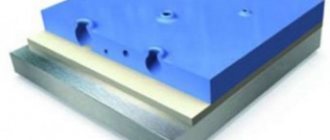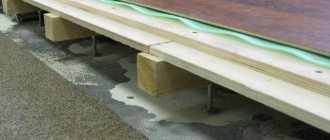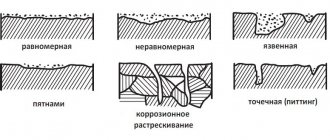All domestic bathrooms are equipped with a heated towel rail. After all, he has such a role! Entering almost any bathroom of our compatriots, you can see things drying on it after a little “washing”, children’s mittens dangling after a winter party and much more. But the main functionality of this device is to heat the room and maintain a dry climate in a humid environment. And its failure means not only the loss of a place for drying, but the appearance of dampness in the bathroom and its attendant troubles: fungus and mold. These factors lead to damage to the finish and make staying in the bathroom uncomfortable. If the dryer is made of steel, as in most cases, then as it cools down, corrosion processes begin. This is already fraught with depressurization of the pipe and flooding of the home. What to do if the heated towel rail stops heating? How to deal with this problem? What factors lead to equipment losing its operational properties? Let's look further.
Why does the water heated towel rail not heat up?
An analysis of the situation with malfunctions of heated towel rails (abbreviated as HS) shows that a violation of their thermal efficiency occurs for several reasons:
- incorrect installation;
- unqualified interference in the work of engineering structures;
- general condition of heating and hot water supply systems;
- quality and parameters of coolant supply.
In order for the heated towel rail not only to look good in the interior, but also to provide effective heating, it is necessary to carry out the installation in accordance with the laws of hydrodynamics
As you yourself understand, it is almost impossible to influence the latest circumstances. All that can be done in this case is to try to force utility workers to fulfill their direct responsibilities. But any more or less educated person can check the correct connection and find the “weak link” in the heated towel rail-DHW system chain. But first, let's figure out how a heating device can be powered and find out the reasons for the drop in its thermal power.
Varieties and design features
Today you can find two types of heated towel rails on the market:
- electrical;
- aquatic.
The convenience of electric models is their high mobility and low power consumption. They can be used in almost any room that has an electrical outlet. As for the water one, such a heated towel rail has a curved shape, inside which hot water circulates.
As a rule, these devices, regardless of type, are used in the bathroom. The appearance of the devices can be standard or modernized, it all depends on the choice of pipe.
Expert advice: when choosing a heated towel rail, you should look at the hygiene coupon, product data sheet, pay attention to the end and outside, which should be smooth.
Typical connection diagrams for heated towel rails
In houses of the old housing stock, a section of the riser curved in the shape of the letter “C” or “M” was used to heat bathrooms and bathrooms. The simplicity of such a PS, however, has a number of advantages. Being connected in series to the DHW circuit, the device ensures constant temperature, eliminates interference in the operation of the system by other residents and has virtually no effect on the hydraulic resistance of the main line.
A heated towel rail in the form of a riser section, although it has an unsightly appearance, is at the same time the most unpretentious heating device
With the advent of more aesthetically pleasing stainless steel heated towel rails, the need arose to replace previous devices with the least interference in the operation of the heating system. The ideal situation can be considered when the internal diameter of the riser is equal to the cross-section of the contour of the new substation. Of course, if the heating device is installed using couplings and bends of the appropriate diameter.
A complete replacement of a simple heated towel rail with a modern device made of stainless steel is only possible if fittings with a full flow area are used - there is no question of installing ball valves
Before you start analyzing the connection diagrams for heated towel rails, you need to find out which engineering system - heating or hot water supply - it is connected to. The fact is that the heating device will only work in hot water systems with constantly circulating coolant. In the case of using the so-called dead-end circuit, the substation will warm up only when the hot water tap is open.
If taps and fittings are used to connect the heated towel rail, or if the new heating device consists of pipes of smaller diameter than the riser, then it is necessary to use a bypass . Being, in fact, a workaround for the coolant, this simplest device makes it possible to:
- maintain coolant circulation through the riser even if the substation is connected with pipes of minimum diameter;
- regulate the temperature of the substation or dismantle it without affecting the general heating system or hot water supply (installation of shut-off valves or a thermostatic device is required);
- By passing the main coolant flow through itself, the bypass ensures a constant coolant temperature for all apartments in the house.
Depending on the installation diagram, a straight (1), narrowed (2) and offset (3) bypass is used
Over time, developers abandoned the installation of simple substations, leaving residents the right to choose and install a heating device. To do this, they began to make connections on the riser for the heated towel rail, while simultaneously ensuring normal coolant flow through a direct or offset bypass. It must be said that there is absolutely no reason to worry about the performance of such schemes - water is guaranteed to circulate through the heating device thanks to the “gravity pump” principle. It is based on the fact that the cooling coolant falls down and is replaced by masses of hotter water coming from above.
The thermogram of a heated towel rail operating on natural circulation indicates the high thermal efficiency of the “gravity pump”
For the same reason, the installation of a substation is considered the most effective, in which the coolant is supplied to the upper part of the heating device and taken from the bottom. This condition can be ensured with both lateral and diagonal connections.
The opinion that the latter method has an advantage in terms of flow rate and thermal efficiency is greatly exaggerated. However, one of the best schemes is considered to be the one in which the coolant is supplied to the near upper corner, and the return is connected to the remote lower corner.
A lateral direct or diagonal connection will not cause any surprises if the connection is made taking into account the required slopes
In this case, the performance of the substation does not depend on the speed and direction of the coolant supply, and the risk of airing the device tends to zero. The only condition is that slopes of at least 3 mm per 1 linear line must be observed. m highway.
With a lateral connection, it does not matter at all whether the substation is located between the supply and return points or protrudes beyond them. The only thing that needs to be taken into account is a significant increase in the risk of airing the device if its upper part is located above the branch along which the heated towel rail is connected to the riser.
Installing a heated towel rail above the point of insertion into the main increases the risk of air locks - in this case, you will need to install an air vent (Mayevsky tap)
The bottom connection of the heating device is considered less efficient and may cause its unstable operation.
The operation of heated towel rails with bottom connections very much depends on the pressure and direction of coolant supply, so several connection schemes are used - with a straight, offset or narrowed bypass
This type of installation is recommended for use only with top supply, as well as in systems with forced circulation of coolant.
How to start?
Now let’s try to figure out how to eliminate the above-mentioned problems and get the heated towel rail into working condition. Let's start with a situation where an air plug has formed in the system. Removing the air can help here.
The easiest way to do this is in a private house, where the owner knows the structure of the water supply mechanism and where the tap is located, when opened, the air can be released. If the house is multi-story, then there is a high probability that it will be necessary to bleed the entire riser. The algorithm of actions will depend on the type of building, because the structure of the riser varies everywhere:
- In 5-story buildings built in Soviet times, the hot water riser goes to the last floor, after which it goes down again. Air accumulation usually occurs on the top floor at the highest point. And the descent should be made here. Usually in apartments on the top floors there is a special hose on the top tap of the riser. When you turn the valve, water flows out of the hose until the air cushion disappears.
- In 9-story panel-type buildings, all communications usually end in the attic, which is why all problems will be eliminated there. Considering that there is not always access there, you will have to call a plumber from the organization that services the house. If you have access, then you can do everything yourself. The procedure here will be the same as in the case of 5-story buildings.
- In other types of buildings, you should not engage in arbitrariness and you need to call a plumber who will carry out all the necessary actions.
If we talk about removing air directly from the heated towel rail, then there are 2 solutions. If the equipment is old, then the algorithm of actions will be as follows.
You should place a container under the equipment where the water will drain. This will prevent the room from flooding. Using an adjustable wrench, you need to unscrew the nut that connects the dryer to the hot water pipe
You need to be extremely careful not to strip the threads. This is especially important if the equipment is really old. You must wait until the hissing stops and water begins to pour into the container. Carefully tighten the nut.
If the heated towel rail model is relatively new, then everything will be much simpler, because it is equipped with a special air bleeder, which is called a Mayevsky tap. In essence, it is a shutter in the shape of a narrow, cone-shaped cylinder. Its components are a locking screw, as well as inlet and outlet openings, which are small in size.
To bleed air using such a device, you will need:
place a container where the water will drain under the above-mentioned tap; using a screwdriver or wrench, carefully turn the special screw (it is important not to overdo it here, so that later there will be no problems with installing this element back); wait until the hissing sound disappears from the hole and water flows out without air particles in the form of bubbles; carefully close the tap.
If it is determined that the cause of the breakdown is that the heated towel rail is clogged, then it will need to be cleaned. To do this, you need to remove it for a while. The washing process itself is carried out as follows.
- Turn off the hot water tap to prevent water from spilling onto the floor. To be on the safe side, we install plugs on the pipes.
- After this, we unscrew the nuts that secure the device. To do this, you can use a special pipe wrench. We dismantle the heated towel rail.
- Use a soft wire rope equipped with a brush at the end to clean the towel. To knock down salt deposits from the inner surface that have already hardened, you will need to tap the device.
- Now we rinse using strong water pressure. The best way to do this is to put a hose on the tap and put its other end inside the heated towel rail.
- If it becomes clear that water comes out of the heated towel rail perfectly, it can be replaced.
If the problem is turning off the hot water, and the heated towel rail is built into the heating pipe, then the only solution here is to transfer it from this pipe to the hot water supply pipe. But nothing can be done here on your own, and you will need to involve heating system specialists and plumbers.
If there is simply no coolant circulation, then you can still try to drain the hot water in the most basic way. You just need to open all the taps in your home - in the kitchen and bathroom. The method can hardly be called cheap, but sometimes it helps.
We eliminate the causes of ineffective work
Although a heated towel rail is a fairly simple device, finding the reason for ineffective operation can be difficult. To reduce time and not do unnecessary work, the search for the “weak link” is carried out according to a certain algorithm:
- de-air the heating device;
- determine the hot water pressure at the inlet to the heated towel rail. This can be done either with a special device - a pressure gauge, or using one of the calculation methods;
- analyze and eliminate the causes that lead to a drop in pressure in the circuit;
- the heated towel rail is dismantled and cleaned of dirt and deposits.
If the heated towel rail does not heat up at normal pressure in the DHW system and there is good flow through the circuit, it means it is installed incorrectly. In this case, it is necessary to change the connection diagram, and possibly move the device to another location. We'll move on to a look at installation errors and how to fix them a little later. Now let's remember the simplest methods for solving the problem.
How to remove air locks
You can check whether an air lock is the cause of the trouble and remove it from the heated towel rail using a special air vent, which is also called a radiator air valve or Mayevsky tap. To do this, the valve locking screw (needle) is turned out of the seat so much that air begins to hiss out of the radiator.
The process of removing an air lock using a Mayevsky tap does not cause any difficulties - any home craftsman can handle this procedure
You can determine the end of the process by a thin stream of water without bubbles or hissing, which will begin to flow out of the valve hole. After this, Mayevsky’s tap is turned off and checked to see if the coil has begun to heat up.
If the heated towel rail is built into an individual heating system, de-aeration of one device is not enough - a comprehensive removal of air from the entire system will be required, starting from the boiler and ending with the radiator in each room. In systems with forced circulation of coolant, it is better to turn off the pumps - this prevents the movement of air pockets and facilitates their complete removal.
Often our readers are faced with a situation where the heated towel rail was initially installed without an air vent. In this case, we recommend installing this useful and inexpensive device - in the future it can save you a lot of time and effort.
The simplest design makes the Mayevsky crane reliable and easy to use
As a temporary measure, it is recommended to bleed the air by depressurizing the circuit. To do this, you need to stock up on some kind of container (a bowl or bucket), and lay a rag on the floor under the PS. Next, you should slightly unscrew the top nut, with which the “towel” is connected to the riser. At the same time, water mixed with air bubbles will begin to ooze from under the connection. After waiting until the hissing stops, the tightness of the system is restored.
Video: how to bleed air from a heated towel rail
How to get rid of blockages
In old “Stalin” and “Khrushchev” buildings, utility lines are so worn out that blockages and breaks due to rusty pipes are as common as air leaks. To remove the blockage, you need to turn off the water and disconnect the heated towel rail from the riser. At the same time, several liters of water remain in the coil, so it is better to place some empty bowl or bucket under it.
To determine in which part of the circuit the blockage is located, a hose with good water pressure is connected to one of the outlets of the heated towel rail, and the second is lowered into an empty container or bathtub. A decrease in water flow pressure indicates that the coil needs cleaning.
Oxalic acid is an excellent agent for removing scale, rust and calcium deposits
To remove internal deposits, both mechanical and chemical methods are used. In the first case, you can use a plumbing cable with a small homemade brush at the end. It is introduced inside and with translational and rotational movements the walls of the device are cleaned of scale and rust.
To clean the inner surface of the heated towel rail and heating and hot water system pipes, you can use a plumbing cable with a metal brush
In case of severe contamination and the presence of persistent deposits, you cannot do without special chemical reagents such as “Mole”, “Mr. Muscle”, “Brawler”, etc. Dissolved chemicals are poured into the device with the pipes installed upward and kept for the time indicated on the packaging.
Along with household chemicals, folk remedies can also be used to clean heated towel rails. For example, a good result is obtained by combining a solution of acetic acid and regular baking soda poured into a heating device.
The most stubborn deposits of rust and scale can be removed by dry cleaning using a hydrodynamic method
In cases where a drop in pressure occurs due to old, clogged pipes, you can try to restore their permeability using a plumbing cable. If this option does not give the expected result, then one of the companies that provides hydraulic pipe cleaning services (using high-pressure units) can be involved in solving the problem.
What to do if circulation in the DHW circuit is disrupted for subjective reasons
When looking for the reasons that lead to a decrease in pressure, the human factor cannot be discounted. Most often, the heated towel rail is connected to the return line of the hot water supply with constant circulation, thanks to which it is possible to maintain the temperature of the hot water within the specified limits. In order to ensure equal thermal conditions for each consumer, all outlets from the riser are equipped with bypasses. It is thanks to these simple sections of the pipeline that it is possible to avoid a significant difference in the temperature of the hot water between the first and last points.
Installing taps and plugs on the bypass is prohibited, as it changes the hydrodynamic characteristics of the hot water system
In order to increase the temperature of the substation in a separate apartment, it is enough to close the bypass using a ball valve - in this case, the entire flow of hot water will go through the heating device. The result of such “innovations” is a drop in temperature and an increase in the hydraulic resistance of the system. You can guess for yourself that several “innovators” living in your building are capable of leaving the bathrooms of all other apartments without heat. That is why carrying out work that can change the hydrodynamic parameters of the hot water supply system is prohibited by law.
Another example of an irresponsible attitude towards communal communications is the removal of a heated towel rail created by bending the riser without restoring the integrity of the latter. In other words, during the renovation, one of the neighbors cut out the unaesthetic structure and installed plugs at the ends of the pipes. In this case, bypassing this apartment, it is necessary to install a jumper from the same pipe that made the riser.
Installation of shut-off valves on the riser is prohibited not only to avoid interference by residents in the operation of the hot water supply system, but also due to the increase in hydraulic resistance of the main line
According to sanitary standards, it is possible to turn off the hot water supply only in case of repairs or maintenance work, so substations must be heated in any season. In reality, with the end of the heating season, the housing office often turns off the return branch in the DHW circuit, transforming the circulation connection circuit into a dead-end one. In this case, the heating device will only work when the “hot” tap is opened.
If you are confident in the correct installation and serviceability of communications, you should talk to your neighbors or file a complaint with the management company. If this does not help, then you have two options to solve the problem. The first is to become the same offender by reconnecting to the DHW supply branch, shutting off the bypass or installing an additional circulation pump. The second is to remain a law-abiding citizen, power the device from the heating system or install an electric (combined) device.
Modern electric heated towel rails are equipped with thermostats that allow you to regulate the temperature of the device over a wide range
Correcting installation errors
All the methods described above for restoring the functionality of a heated towel rail are quite simple even for people who have picked up an adjustable wrench for the first time. Much more difficult is the situation with the heated towel rail, which was installed in violation of the laws of thermodynamics.
One of the most common mistakes is a lateral or bottom connection, in which the heating device (in whole or in part) is installed below the point where the return line inserts into the riser. In this case, gravitational forces are not enough to create the pressure necessary to lift the cooled coolant layers to the level of the return pipeline. Of course, natural circulation will not work in this case.
An error in installing the return line above the bottom point of the heated towel rail makes circulation of the coolant impossible
Often, for the sake of convenience and aesthetics, careless craftsmen connect a heated towel rail, hiding the supply pipeline behind the suspended ceiling, and lay the return line under the floor. The “loop” located in the supply area is an excellent trap for air bubbles - a plug formed in this place will most likely block the path of water flow. As for the lower “loop,” it prevents the cooled coolant from being pushed out for the reasons already discussed above.
Attempts to hide the heated towel rail connections in the floor or behind the ceiling lead to the formation of “loops” that impede or completely stop the circulation of hot water
If the connection diagram includes an offset or narrowed bypass, then with a lower supply of coolant, the forced circulation pressure can be equalized with the efforts of the “gravity pump”. In most cases this does not happen because the pump “wins”. And, nevertheless, stopping the flow of hot water can be caused either by lengthening the connecting lines and reducing their cross-section, or by installing a bypass tap by one of your neighbors.
A circuit with a narrowed or offset bypass is best used with an upper coolant supply
To correct the situation, a complete or partial change in the connection diagram is necessary. You may even need to move the “towel” to a new place. If such measures do not suit you, then you can correct the situation by installing a circulation pump in the circuit. The only thing you need for this is to find out from specialists from the housing office the direction of movement of the coolant in the riser.
Read about all the features of moving a heated towel rail to another location here:
In all other cases, you should take into account the recommendations of experienced plumbers. So, for all cases of lateral connection (including diagonal), the following conditions will need to be met:
- the upper outlet of the heated towel rail should be below the outlet of the riser, and the lower pipe - above the entry point of the return line;
- there should be no “loops” on the highway;
- the cross-section of the pipeline must take into account the hydraulic resistance of the coil;
- if the upper crossbar of the PS is located above the hot water sampling point, then the heating device must be equipped with a Mayevsky tap.
If all the necessary conditions are met, then no bends in the connecting pipeline can interfere with the normal operation of the design radiator
With a lower connection, the following will help correct the situation:
- moving or changing the bypass cross-section;
- compliance with the required slopes and removal of “loops” from the diagram;
- ensuring the condition that the corresponding riser outlets will be located below the connection points of the “towel”.
When considering the bottom connection diagram, you should definitely analyze the direction of water flow when it is cooled in the coil and determine whether it will circulate with the top or bottom supply.
The erroneous opinion that without installing a narrowed bypass, water will not circulate through the device’s coil leads to unjustified installation of bypass sections with a reduced flow area. But in a circuit with a lower coolant supply and weak circulation, such a narrowing can precisely be the reason why the coil remains cold. The cross-section of the bypass section should not be reduced by more than one step, and in the case of a displaced bypass, this is not recommended at all.
If the heated towel rail does not heat with a lateral or diagonal connection and an offset or narrowed bypass is used, then you should check the direction of movement of hot water in the riser. As noted above, with lower supply such schemes are inoperative due to the fact that the circulation of the coolant is hampered by the operation of the “gravity pump”.
You will receive more information about the methods of installing heated towel rails and installation technology by reading this article:
Types of water supply in houses
The type of water supply affects the installation of the heated towel rail.
Let's consider ways to supply water at home:
- Circulating (loop). Installed in almost all apartments of multi-apartment buildings. Water is supplied through the drain and flows out through the return. This principle does not allow hot water to cool. Heated towel rails should be connected to the return system as they will be very hot.
- Dead end . The operating principle is based on direct supply of hot water to the consumer. One of the disadvantages of this method is that if the water is not used for a long time, then in order to start the heated towel rail, it has to be drained.
Please note: if there is no hot water in the house or if the system is a dead end, the device should be connected to the heating system using a loop type.
Causes of breakdowns and troubleshooting methods for electric heated towel rails
Electric heated towel rails (often called design radiators) have a sufficient margin of reliability, but, like any other equipment, they can fail due to exhaustion, internal defects, overheating or power surges in the network.
Depending on the design, there are two types of electric design radiators - solid-filled and liquid. Heat transfer in the former is ensured by graphite and other compounds, while the latter operate by heating specially prepared water, antifreeze or a mixture of mineral oils. Solid-filled design radiators can use either a traditional spiral or tubular electric heater, or a heating film or cable. Liquid “towels” are built using traditional “dry” or conventional heating elements.
You can learn more about choosing and connecting electric heated towel rails from this article:
Design and installation diagram of an electric heated towel rail
In order to find the cause of the breakdown of an electric heated towel rail, you will need a multimeter, a set of screwdrivers and an adjustable wrench. The search begins with checking the integrity of the electrical circuit, gradually moving towards the power elements:
- check the presence of mains voltage in the outlet;
- “ring” the power cord with a multimeter - its resistance should not exceed 1-2 Ohms;
- when the substation is connected to the network, the voltage at the terminals of its heater is measured. If the multimeter shows the presence of 220 V, then this is indirect evidence of failure of the heating element;
To check the electric heater, use a multimeter turned on in resistance measurement mode. An infinitely large value indicates an internal break. The resistance of a working heating element should not exceed several tens of ohms.
- if there is no supply voltage at the heater terminals, check the serviceability of the contact group or the thermostat relay - the cause of the malfunction can be either burnt contacts or a poor electrical connection;
- if an electronic rather than a mechanical thermostat is used to control the temperature of the heated towel rail, then the reason for the lack of voltage on the heating element is more difficult to find. First of all, you should check the output relay or power semiconductors - powerful transistors, thyristors or triacs of the output stage. If they are in good working order, other components of the circuit are checked. If you do not have experience in repairing electronic devices, then it is better to entrust such work to a specialist.
All you need to diagnose and repair an electric heated towel rail is a multimeter, an adjustable wrench and a set of screwdrivers
Replacing the heating element in a heated towel rail is easy. If the type of device is unknown, then before disassembling it, the coil should be turned over so that the working fluid does not leak out. Then use an adjustable wrench to unscrew the nut on its flange, dismantle and replace the heater. Don't forget to check if there is any current leakage on the design radiator body. To do this, one multimeter probe is connected to the metal surface of the heated towel rail, and the other touches the heating element terminals in turn - the device should show an infinitely high resistance.
Burnout of the heating element is the main cause of failure of electric heated towel rails
Before assembling the heater, the level of the working fluid should be replenished (if there were leaks or some of the oil leaked out during operation), leaving room for thermal expansion . After this, check the integrity of the sealing gaskets and, if necessary, replace them with new ones. Next, with a force sufficient to ensure tightness, tighten the flange nut and check the performance of the heater in various modes.
What to do
The first step is to determine what type of device you are using: electric or water.
In the case of an electric heated towel rail, check the connection to the outlet; if this does not help, use a tee and connect the device to another outlet.
With a water heated towel rail, the following problems may occur:
- The valve on the riser is closed. By opening the tap, the problem will be solved.
- There is no return line on the riser, or it is located before the heated towel rail. The problem can only be solved by connecting an electrical device.
- The device is installed on the heating system pipe. The heated towel rail will only become hot when the heating is turned on.
Please note: the problems and solutions listed above only apply to new heated towel rails that have not yet been used.










